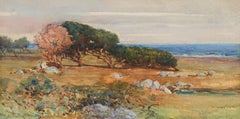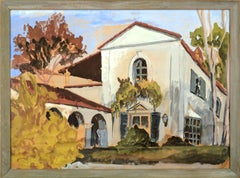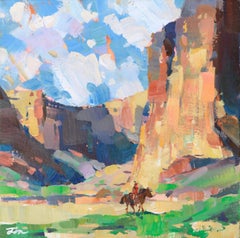Elmer Wachtel Art
Elmer Wachtel was an American artist who held a high place in the early California school of Impressionism. He was born in Baltimore, Maryland on January 21, 1864. He received his artistic training at the Art Students' League of New York under William Merritt Chase and the Art School in London, 1901–02. While in California, he resided and maintained studios in Los Angeles and Pasadena. In 1904, Wachtel married the artist Marion Kavanaugh (1876–1954) in Chicago. Husband and wife were frequently seen painting the Southern California landscape, they were known to have traveled by horseback over the San Marcos Pass to the Santa Ynez Valley. They traversed and painted the coastline between Gaviota and Conception Lighthouse which is just north of Santa Barbara, California, the Cooper Ranch at the north of Santa Barbara, Matilija Canyon and Ojai, California. Venturing south, the couple made it to the San Luis Rey River (near present-day Oceanside) and the Cerisa Loma Ranch (near San Diego). In 1908, they trekked to the arid deserts of Arizona and New Mexico, painting the historic pueblo villages on the Moki and Navajo reservations. During their marriage, Marion specialized as a general rule in watercolors while Elmer stayed with oils. In 1906, a Los Angeles Times critic noted, "Elmer knows Southern California perhaps more intimately than any other artist. He paints her directly, simply, truthfully, and yet never with topographic hardness and realism..."
Early 1900s American Impressionist Elmer Wachtel Art
Paper, Watercolor, Gouache
Mid-20th Century American Impressionist Elmer Wachtel Art
Paper, Gouache, Cardboard
2010s American Impressionist Elmer Wachtel Art
Gouache, Cardboard
1910s American Impressionist Elmer Wachtel Art
Gouache
Early 20th Century American Impressionist Elmer Wachtel Art
Watercolor, Laid Paper
Early 1900s American Impressionist Elmer Wachtel Art
Watercolor, Gouache
1930s American Impressionist Elmer Wachtel Art
Paper, Watercolor, Drypoint
1970s American Impressionist Elmer Wachtel Art
Paper, Watercolor
1910s American Impressionist Elmer Wachtel Art
Watercolor, Gouache, Board
Late 20th Century American Impressionist Elmer Wachtel Art
Paper, Watercolor
Early 20th Century American Impressionist Elmer Wachtel Art
Gouache
Early 1900s American Impressionist Elmer Wachtel Art
Pastel, Gouache
1950s American Impressionist Elmer Wachtel Art
Paper, Watercolor


